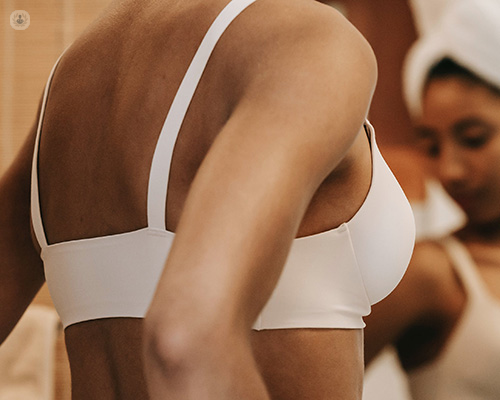Your essential guide to breast augmentation with implants
Written by:Breast augmentation, or augmentation mammoplasty, is surgery to increase the size and shape of the breasts either using breast implants or fat transfer.
Here, Mr Robert Warr, renowned consultant plastic, reconstructive and cosmetic surgeon based in Bristol, provides an expert insight into breast augmentation surgery with implants.

What happens during an initial consultation for breast augmentation surgery?
An initial consultation is a crucial step in the process for patients who are preparing or considering breast augmentation surgery. During this consultation, you will meet with your plastic surgeon to determine if breast augmentation surgery is the right option for you.
There are several points of discussion involved, including:
- Medical history and physical examination: Your plastic surgeon will review your medical history, including any existing medical conditions, previous surgeries, and any medications that you are taking. In addition, a physical examination of the breasts will be performed to assess symmetry, breast size and shape, nipple placement, and skin quality.
- Patient expectations: You will have the opportunity to discuss your reasons for choosing breast augmentation surgery and your expectations. It’s important that you are open and honest with your plastic surgeon so that your surgeon understands what you want to achieve with the procedure.
- The surgery itself: Your plastic surgeon will explain the different breast implant options available, discussing the pros and cons of each type, and the recommended surgical techniques. This will also involve discussions about incision locations and implant placement options.
- Risks and recovery: You will be informed about the potential risks and complications associated with breast augmentation surgery, and your surgeon's approach to minimising these risks. In addition, your surgeon will also provide you with information about the expected recovery process following breast augmentation surgery.
What type of breast implants are available for breast augmentation surgery, and how can I choose the right implant size and shape for me?
In the UK, the two primary types of breast implants available for breast augmentation surgery are silicone implants and saline implants. However, silicone implants are generally preferred for their natural feel.
Silicone implants are filled with a silicone gel that closely resembles the feel of natural breast tissue. They come in various shapes including round and anatomical (teardrop), and in different profiles (projection levels) including low, moderate, high, and extra-high profile, which affect how far the implant projects from the chest wall.
Saline implants, typically available as round implants, are filled with sterile saline (saltwater) solution after they are placed inside the breast. They are adjustable in terms of volume during surgery and have a slightly firmer feel compared to silicone implants.
Choosing the right breast implant and size is a collaborative effort between you and your plastic surgeon. Your surgeon will help you choose implant sizes and shapes that are realistic and achievable, based on your body proportions, breast anatomy, and desired surgical outcome.
This process involves several considerations, including:
- A physical examination: Your surgeon will perform a physical examination to assess breast tissue, chest wall dimensions, and skin quality.
- Measurements: Measurements such as breast width, nipple-to-fold distance, and existing breast volume will be considered when choosing implant size and profile. This will ensure that the selected implant fits your body as it should.
- Size consideration: There are a number of ways to find the best implant size. Over many years, I have found the rice test to be the best, simplest and most reliable. I will explain exactly how this is done during your consultation.
- Lifestyle considerations: It’s important to consider lifestyle, activity level, and clothing preferences when choosing implant size and shape. I always take a bespoke approach as what looks and feels right for one individual may not be suitable for another.
Can you explain the breast augmentation procedure in detail?
Breast augmentation surgery is performed under general anaesthesia to ensure that you are pain-free and comfortable during the procedure.
After making an incision, I will create a pocket to accommodate the breast implant. I will then carefully insert the chosen implant into the created pocket.
Once the implant has been positioned correctly, I will close the incision using sutures or surgical adhesive, taking special care to minimise scarring. Sterile dressings and bandages will then be applied to the incision, and a supportive surgical bra or garment will be provided to support the breasts during the initial recovery period.
Where is the incision made, and where are the implants positioned?
There are several incision options available, including:
- Inframammary incision: Made in the crease beneath the breast (the inframammary fold). It allows for precision implant placement, and the scar is typically well-concealed. This is the option that I personally recommend.
- Periareolar incision: Made around the edge of the areola (the darker area around the nipple). The scar blends in with the natural transition between the areola and the surrounding skin.
- Transaxillary incision: Made in the armpit, which avoids any scarring on the breast itself.
The choice of incision depends on several factors, such as the type of implant, your body proportions, and your surgeon’s recommendation. After the incision has been made, the breast implants can be positioned either in a submuscular or a subglandular placement.
In a submuscular (subpectoral) placement, the breast implant is positioned beneath the chest muscle (called the pectoralis major). The benefits of this placement include an improved long-term breast health for mammography screenings and a reduced risk of visible rippling or wrinkling of the implant.
In a subglandular (submammary) placement, the breast implant is positioned between the chest muscle and the breast tissue. The benefits of this placement include a quicker recovery period and a more noticeable upper breast fullness, which is preferred by some patients. In addition, a subglandular placement often also results in a more natural look overall as the muscle provides additional coverage and support for the implant.
What is the recovery process like after breast augmentation surgery?
In the first week after surgery, you will experience some discomfort, swelling, and bruising, but this is normal and can be managed with prescribed pain medication. Sterile dressings and bandages may also cover the incision sites. During this period, you will be instructed to wear a surgical bra or a support garment to aid in your recovery.
In the 2-6 weeks after surgery, your breasts will start to settle into their final position. Some patients may experience temporary changes in nipple sensation during this period. You can start engaging in low-impact exercises, such as walking, but high-impact activities and heavy lifting should be avoided for a more extended period. You can also gradually return to your regular activities, including work, as long as they do not involve heavy lifting.
After 3-6 months, the final results of your breast augmentation surgery will be fully visible. However, recovery experiences can vary between patients, so it’s important that you give your body the time it needs to heal properly. You will have several follow-up appointments with your surgeon throughout all the recovery period, as well as after, to monitor any changes and ensure that your healing is on track.
Do breast implants have a lifespan?
Breast implants have a lifespan. Both silicone and saline implants typically have a lifespan ranging from 10 to 20 years. For this reason, patients who undergo breast augmentation surgery should be prepared for the possibility of implant removal or replacement in the future.
Besides the natural end of the implant’s lifespan, some reasons for implant replacement include:
- Implant rupture or deflation
- Capsular contracture (scar tissue around the implant)
- Changes in physical appearance (such as changes in weight, pregnancy, or breastfeeding)
Regular monitoring and follow-up appointments with your plastic surgeon will help to assess the condition of the implants, address any issues that may arise, and provide guidance on whether implant replacement may be necessary.
Mr Robert Warr is a highly distinguished consultant plastic, reconstructive and cosmetic surgeon with over 30 years’ experience performing breast surgery.
If you are considering breast augmentation surgery, with or without implants, don’t hesitate to book an appointment with Mr Warr via his Top Doctors profile today.


